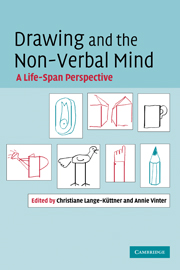Book contents
- Frontmatter
- Contents
- Contributors
- 1 Contemporary enquiries into a long-standing domain: Drawing research
- Part I Self, symbols and intention
- Part 2 Syntax, space systems and projection
- 7 The interaction of biomechanical and cognitive constraints in the production of children's drawing
- 8 Graphic syntax and representational development
- 9 Spatial structures in children's drawings: how do they develop?
- 10 Figures in and out of context: absent, simple, complex and halved spatial fields
- 11 Spatial and symbolic codes in the development of three-dimensional graphic representation
- 12 On contours seen and contours drawn
- Part III Aging, blindness and autism
- Index
- References
11 - Spatial and symbolic codes in the development of three-dimensional graphic representation
Published online by Cambridge University Press: 22 September 2009
- Frontmatter
- Contents
- Contributors
- 1 Contemporary enquiries into a long-standing domain: Drawing research
- Part I Self, symbols and intention
- Part 2 Syntax, space systems and projection
- 7 The interaction of biomechanical and cognitive constraints in the production of children's drawing
- 8 Graphic syntax and representational development
- 9 Spatial structures in children's drawings: how do they develop?
- 10 Figures in and out of context: absent, simple, complex and halved spatial fields
- 11 Spatial and symbolic codes in the development of three-dimensional graphic representation
- 12 On contours seen and contours drawn
- Part III Aging, blindness and autism
- Index
- References
Summary
Tallandini investigates the dissociation of the spatial code and the semantic (or symbolic) code in drawing. She tested a model of drawing which assumes two pathways of attention to the real object. Children could either draw only paying attention to the surface properties (spatial code) which should enhance visually realistic drawing, or they would draw more meaningful objects (semantic code) where attention is diverted between spatial and semantic aspects, and thus the more early intellectually realistic drawing style should pervade. Tallandini asked children and adults to copy aggregates of cubes in different conditions, (1) plain and purely geometrical, (2) with features of a doll, (3) with a part (the head) rotated, (4) with the entire figure rotated. Using a 7-point Q3DS-scale, she found that the more complex the spatial aspects, i.e. object orientation and position, and the less semantic aspects, the better the quality of the level of the projective system, in both children and adults. It is concluded that semantic content, the ‘what’, interfered with the construction of spatially complex figure constructions, the ‘how’, a clear dissociation between the spatial and the semantic code in drawing.
from a historical perspective, Piaget (1977) identified two inextricable aspects of knowledge (Feldman, 2000): the ‘figurative’, which concerns an object's physical reality (e.g. colour, texture, position, size, weight, etc.) and the ‘operative’, which corresponds to the ways in which that object is understood.
Information
- Type
- Chapter
- Information
- Drawing and the Non-Verbal MindA Life-Span Perspective, pp. 217 - 238Publisher: Cambridge University PressPrint publication year: 2008
References
Accessibility standard: Unknown
Why this information is here
This section outlines the accessibility features of this content - including support for screen readers, full keyboard navigation and high-contrast display options. This may not be relevant for you.Accessibility Information
- 4
- Cited by
